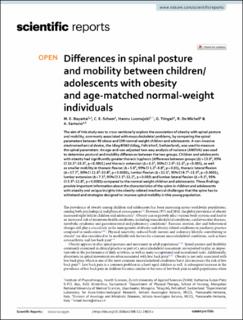Please use this identifier to cite or link to this item:
https://doi.org/10.21256/zhaw-25802| Publication type: | Article in scientific journal |
| Type of review: | Peer review (publication) |
| Title: | Differences in spinal posture and mobility between children/adolescents with obesity and age-matched normal-weight individuals |
| Authors: | Bayartai, M. E. Schaer, C. E. Luomajoki, Hannu Tringali, G. De Micheli, R. Sartorio, A. |
| et. al: | No |
| DOI: | 10.1038/s41598-022-19823-z 10.21256/zhaw-25802 |
| Published in: | Scientific Reports |
| Volume(Issue): | 12 |
| Issue: | 1 |
| Page(s): | 15570 |
| Issue Date: | 16-Sep-2022 |
| Publisher / Ed. Institution: | Nature Publishing Group |
| ISSN: | 2045-2322 |
| Language: | English |
| Subjects: | Adolescent; Child; Human; Lumbosacral region; Posture; Spine; Kyphosis; Pediatric obesity |
| Subject (DDC): | 616.7: Diseases of musculoskeletal system and orthopaedics 618.92: Pediatrics |
| Abstract: | The aim of this study was to cross-sectionally explore the association of obesity with spinal posture and mobility, commonly associated with musculoskeletal problems, by comparing the spinal parameters between 90 obese and 109 normal-weight children and adolescents. A non-invasive electromechanical device, the Idiag M360 (Idiag, Fehraltorf, Switzerland), was used to measure the spinal parameters. An age-and-sex-adjusted two-way analysis of variance (ANOVA) was used to determine postural and mobility differences between the two groups. Children and adolescents with obesity had significantly greater thoracic kyphosis [difference between groups (Δ) = 13.00, 95% CI 10.10-15.80, p < 0.0001] and thoracic extension (Δ = 6.50, 95% CI 2.90-11.60, p = 0.005), as well as smaller mobility in thoracic flexion (Δ = 5.00, 95% CI 1.20-8.80, p = 0.01), thoracic lateral flexion (Δ = 17.70, 95% CI 11.60-23.80, p < 0.0001), lumbar flexion (Δ = 12.10, 95% CI 8.70-15.50, p < 0.0001), lumbar extension (Δ = 7.10, 95% CI 3.10-12.20, p = 0.003) and lumbar lateral flexion (Δ = 9.10, 95% CI 5.50-12.80, p < 0.0001) compared to the normal-weight children and adolescents. These findings provide important information about the characteristics of the spine in children and adolescents with obesity and unique insights into obesity-related mechanical challenges that the spine has to withstand and strategies designed to improve spinal mobility in this young population. |
| URI: | https://digitalcollection.zhaw.ch/handle/11475/25802 |
| Fulltext version: | Published version |
| License (according to publishing contract): | CC BY 4.0: Attribution 4.0 International |
| Departement: | School of Health Sciences |
| Organisational Unit: | Institute of Physiotherapy (IPT) |
| Appears in collections: | Publikationen Gesundheit |
Files in This Item:
| File | Description | Size | Format | |
|---|---|---|---|---|
| 2022_Bayartai-etal_Spinal-posture-obesity-children-adolescents.pdf | 2.34 MB | Adobe PDF |  View/Open |
Show full item record
Bayartai, M. E., Schaer, C. E., Luomajoki, H., Tringali, G., De Micheli, R., & Sartorio, A. (2022). Differences in spinal posture and mobility between children/adolescents with obesity and age-matched normal-weight individuals. Scientific Reports, 12(1), 15570. https://doi.org/10.1038/s41598-022-19823-z
Bayartai, M.E. et al. (2022) ‘Differences in spinal posture and mobility between children/adolescents with obesity and age-matched normal-weight individuals’, Scientific Reports, 12(1), p. 15570. Available at: https://doi.org/10.1038/s41598-022-19823-z.
M. E. Bayartai, C. E. Schaer, H. Luomajoki, G. Tringali, R. De Micheli, and A. Sartorio, “Differences in spinal posture and mobility between children/adolescents with obesity and age-matched normal-weight individuals,” Scientific Reports, vol. 12, no. 1, p. 15570, Sep. 2022, doi: 10.1038/s41598-022-19823-z.
BAYARTAI, M. E., C. E. SCHAER, Hannu LUOMAJOKI, G. TRINGALI, R. DE MICHELI und A. SARTORIO, 2022. Differences in spinal posture and mobility between children/adolescents with obesity and age-matched normal-weight individuals. Scientific Reports. 16 September 2022. Bd. 12, Nr. 1, S. 15570. DOI 10.1038/s41598-022-19823-z
Bayartai, M. E., C. E. Schaer, Hannu Luomajoki, G. Tringali, R. De Micheli, and A. Sartorio. 2022. “Differences in Spinal Posture and Mobility between Children/Adolescents with Obesity and Age-Matched Normal-Weight Individuals.” Scientific Reports 12 (1): 15570. https://doi.org/10.1038/s41598-022-19823-z.
Bayartai, M. E., et al. “Differences in Spinal Posture and Mobility between Children/Adolescents with Obesity and Age-Matched Normal-Weight Individuals.” Scientific Reports, vol. 12, no. 1, Sept. 2022, p. 15570, https://doi.org/10.1038/s41598-022-19823-z.
Items in DSpace are protected by copyright, with all rights reserved, unless otherwise indicated.